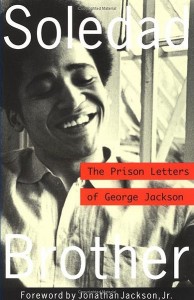AMERICA Is the Prison: Arts and Politics in Prison in the 1970s
 I first read George Jackson’s Soledad Brother in college. I remember being mesmerized by the anger and passion in his letters. His letters are an indictment of American racism and of the country’s treatment of black people in particular. Once I read Soledad Brother, I wanted to read other books written by prisoners so I sought out Eldrige Cleaver’s Soul on Ice among many other books. This experience fed my interest in the prison industrial complex and launched my activism around prison issues especially as they related to violence against women and girls.
I first read George Jackson’s Soledad Brother in college. I remember being mesmerized by the anger and passion in his letters. His letters are an indictment of American racism and of the country’s treatment of black people in particular. Once I read Soledad Brother, I wanted to read other books written by prisoners so I sought out Eldrige Cleaver’s Soul on Ice among many other books. This experience fed my interest in the prison industrial complex and launched my activism around prison issues especially as they related to violence against women and girls.
Over the past couple of days, I have been reading a book called America is the Prison by Lee Bernstein. Even though I am slammed with work, I have had a difficult time putting the book down. It is well-researched and fascinating. The title of the book comes from a quote by Zayd Shakur, who was one of the New York Black Panther 21. Zayd declared that “all of America is a prison where the people are being held captive by the real arch criminals.”
Bernstein meticulously documents the prison arts renaissance of the late 60s into the 1970s. He also highlights the cultural work of prisoners who created powerful works of art (literature, visual, and performance). Bernstein provides an important historical context for understanding why so many penal institutions began to defund arts and educational programs in the 1980s. These are the programs that had ironically provided people like Jackson and Miguel Pinero with platforms for expressing themselves. When these same prisoners used the master’s tools to dismantle the master’s house, repercussions were swift and repressive.
Bernstein provides a valuable window on a time that I knew little about beyond having seen the products of that period several decades later. He has provided invaluable historical context to those works of art in this book. I highly recommend the book.
